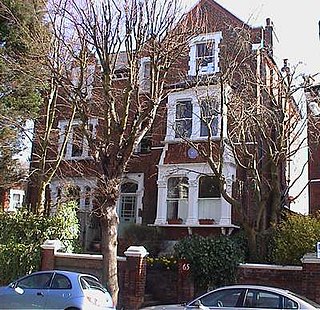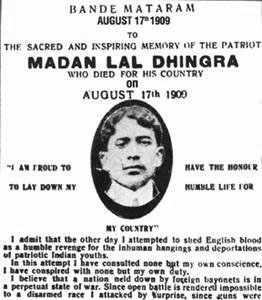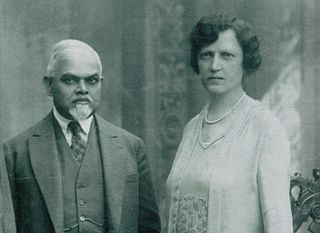
The Indian Independence Movement, was a series of historic events in South Asia with the ultimate aim of ending British colonial rule. It lasted until 1947, when the Indian Independence Act 1947 was passed.

Bhikhaji Rustom Cama or simply as, Madam Cama, was one of the prominent figures in the Indian independence movement.

Shyamji Krishna Varma was an Indian revolutionary fighter, an Indian patriot, lawyer and journalist who founded the Indian Home Rule Society, India House and The Indian Sociologist in London. A graduate of Balliol College, Krishna Varma was a noted scholar in Sanskrit and other Indian languages. He pursued a brief legal career in India and served as the Divan of a number of Indian princely states in India. He had, however, differences with Crown authority, was dismissed following a supposed conspiracy of British colonial officials at Junagadh and chose to return to England. An admirer of Dayanand Saraswati's approach of cultural nationalism, and of Herbert Spencer, Krishna Varma believed in Spencer's dictum: "Resistance to aggression is not simply justified, but imperative".

Indian nationalism is an instance of territorial nationalism, which is inclusive of all of the people of India, despite their diverse ethnic, linguistic and religious backgrounds. Indian nationalism can trace roots to pre-colonial India, but was fully developed during the Indian independence movement which campaigned for independence from British rule. Indian nationalism quickly rose to popularity in India through these united anti-colonial coalitions and movements. Independence movement figures like Mahatma Gandhi and Jawaharlal Nehru spearheaded the Indian nationalist movement. After Indian Independence, Nehru and his successors continued to campaign on Indian nationalism in face of border wars with both China and Pakistan. After the Indo-Pakistan War of 1971 and the Bangladesh Liberation War, Indian nationalism reached its post-independence peak. However by the 1980s, religious tensions reached a melting point and Indian nationalism sluggishly collapsed in the following decades. Despite its decline and the rise of religious nationalism, Indian nationalism and its historic figures continue to strongly influence the politics of India and reflect an opposition to the sectarian strands of Hindu nationalism and Muslim nationalism.

Anushilan Samiti was an Indian fitness club, which was actually used as an underground society for anti-British revolutionaries. In the first quarter of the 20th century it supported revolutionary violence as the means for ending British rule in India. The organisation arose from a conglomeration of local youth groups and gyms (akhara) in Bengal in 1902. It had two prominent, somewhat independent, arms in East and West Bengal, Dhaka Anushilan Samiti, and the Jugantar group.
The Revolutionary movement for Indian Independence was part of the Indian independence movement comprising the actions of violent underground revolutionary factions. Groups believing in armed revolution against the ruling British fall into this category, as opposed to the generally peaceful civil disobedience movement spearheaded by Mahatma Gandhi.

Virendranath Chattopadhyaya, also known by his pseudonym Chatto, was a prominent Indian revolutionary who worked to overthrow the British Raj in India using armed force. He created alliances with the Germans during World War I, was part of the Berlin Committee organising Indian students in Europe against the British, and explored actions by the Japanese at the time.

Sardar Ajit Singh was a revolutionary, an Indian dissident, and a nationalist during the time of British rule in India. With compatriots, he organised agitation by Punjabi peasants against anti-farmer laws known as the Punjab Colonisation Act (Amendment) 1906 and administrative orders increasing water rate charges. He was an early protester in the Punjab region of India who challenged British rule, and openly criticized the Indian colonial government. In May 1907, With Lala Lajpat Rai, he was exiled to Mandalay in Burma. Due to great public pressure and apprehension of unrest in the Indian Army, the bills of exile were withdrawn and both men were released in October 1907.

India House was a student residence that existed between 1905 and 1910 at Cromwell Avenue in Highgate, North London. With the patronage of lawyer Shyamji Krishna Varma, it was opened to promote nationalist views among Indian students in Britain. This institute used to grant scholarships to Indian youths for higher studies in England. The building rapidly became a hub for political activism, one of the most prominent for overseas revolutionary Indian nationalism. "India House" came to informally refer to the nationalist organisations that used the building at various times.
The Berlin Committee, later known as the Indian Independence Committee after 1915, was an organisation formed in Germany in 1914 during World War I by Indian students and political activists residing in the country. The purpose of the committee was to promote the cause of Indian Independence. Initially called the Berlin–Indian Committee, the organisation was renamed the Indian Independence Committee and came to be an integral part of the Hindu–German Conspiracy. Members of the committee included Virendranath Chattopadhyaya, Chempakaraman Pillai, Dr Jnanendra Das Gupta, and Abinash Bhattacharya.
The first Christmas Day plot was a conspiracy made by the Indian revolutionary movement in 1909: during the year-ending holidays, the Governor of Bengal organised at his residence a ball in the presence of the Viceroy, the Commander-in-Chief and all the high-ranking officers and officials of the Capital (Calcutta). The 10th Jat Regiment was in charge of the security. Indoctrinated by Jatindranath Mukherjee, its soldiers decided to blow up the ballroom and take advantage of destroying the colonial Government. In keeping with his predecessor Otto von Klemm, a friend of Lokmanya Tilak, on 6 February 1910, M. Arsenyev, the Russian Consul-General, wrote to St Petersburg that it had been intended to "arouse in the country a general perturbation of minds and, thereby, afford the revolutionaries an opportunity to take the power in their hands." According to R. C. Majumdar, "The police had suspected nothing and it is hard to say what the outcome would have been had the soldiers not been betrayed by one of their comrades who informed the authorities about the impending coup".

Mandayam Parthasarathi Tirumal Acharya was an Indian nationalist, communist and anarchist who was among the founding members of the Communist Party of India. In a long political and activist life, Acharya was at various times associated with India House in London and the Hindu-German Conspiracy during World War I when, as a key functionary of the Berlin Committee, he along with Har Dayal sought to establish the Indian Volunteer Corps with Indian prisoners of war from the battlefields of Mesopotamia and Europe. Acharya subsequently moved in 1919 after the end of the war to the Soviet Union, where he was one of the founding members of the Communist Party of India at Tashkent. However, disappointed with the Communist International, Acharya returned to Europe in the 1920s where he was involved with the League against Imperialism and subsequently was involved with the international anarchist movement.

The Bande Mataram was an Indian nationalist publication from Paris begun in September 1909 by the Paris Indian Society. Founded by Madam Bhikaji Cama, the paper along with the later publication of Talvar was aimed at inciting nationalist unrest in India and sought to sway the loyalty of the Sepoy of the British Indian Army. It was founded in response to the British ban on Bankim Chatterjee's nationalist poem of Vande mataram, and continued the message of the journal Bande Mataram edited by Sri Aurobindo and published from Calcutta, and The Indian Sociologist that had earlier been published from London by Shyamji Krishna Varma.

Madan's Talwar, later known as The Talvar, was an early-20th-century Indian Nationalist periodical published from Berlin.

The Indian War of Independence is an Indian nationalist history of the 1857 revolt by Vinayak Damodar Savarkar that was first published in 1909.
The Indian Home Rule Society (IHRS) was an Indian organisation founded in London in 1905 that sought to promote the cause of self-rule in British India. The organisation was founded by Shyamji Krishna Varma, with support from a number of prominent Indian nationalists in Britain at the time, including Bhikaji Cama, Dadabhai Naoroji and S.R. Rana, and was intended to be a rival organisation to the British Committee of the Indian National Congress that was the main avenue of the loyalist opinion at the time.

Sardarsinhji Ravaji Rana (1870–1957), often abbreviated S. R. Rana, was an Indian independence activist, founding member of the Paris Indian Society and the vice-president of the Indian Home Rule Society.
Abinash Chandra Bhattacharyya was a radical Indian nationalist in the movement for Indian independence who played a role in the Indo-German Conspiracy of World War I. Born in Chunta in the district of Tripura, India, Bhattacharya became involved with the works of the Anushilan Samiti in his youth.
Hindu nationalism has been collectively referred to as the expression of social and political thought, based on the native spiritual and cultural traditions of the Indian subcontinent. "Hindu nationalism" is a simplistic translation of हिन्दू राष्ट्रवाद. It is better described as "Hindu polity".
The history of the Anushilan Samiti stretches from its beginning in 1902 to 1930. The Samiti began in the first decade of the 20th century in Calcutta as conglomeration of local youth groups and gyms(Akhra). However, its focus was both physical education and proposed moral development of its members. From its inception it sought to promote what it perceived as Indian values and to focus on Indian sports e.g. Lathi and Sword play. It also encouraged its members to study Indian history as well as those of European liberalism including the French Revolution, Russian Nihilism and Italian unification. Soon after its inception it became a radical organisation that sought to end British Raj in India through revolutionary violence. After World War I, it declined steadily as its members identified closely with leftist ideologies and with the Indian National Congress. It briefly rose to prominence in the late second and third decade, being involved in some notable incidents in Calcutta, Chittagong and in the United Provinces. The samiti dissolved into the Revolutionary Socialist Party in 1930.













